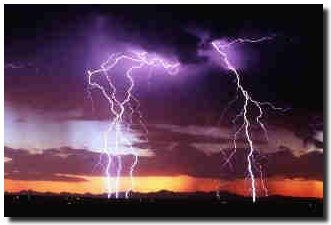
What is Lightning?
Lighting is created of a discharge of built up energy from the seperation of postive and negative charges. This is created in thunderstorm which is the most common occurance but also in volcanic eruptions, extremely intense forest fires, and surface nuclear detonations.
Inside the cloud there is formations of ice particales that seem to be very important in the development of the charge separation that can create lightning. These ice particales collide frequently inside the thunderclound and builds up electric charge. The rates of the rising and sinking air in the thunderstorm creates a seperation of electrical charge to take place. Thus the intensity of the elctrical field develops largely. The frozen upper part of the cloud holds a large positive charge, other parts of the clouds holds a large negative chared region and small positively charged region. The ground normally maintains a small negative charge. When a thundercloud drifts overhead the cloud base induces a positive charge on the ground below. Elevated objects like trees, buildings and higher portions of terrain, attempts to establish a current to equalize the charges between the ground and cloud. However, air is a good inulator and the electrical potential between the clound and ground has to surpass the insulating properties for air to break down and ionize conductive channels to let current flow between the two charges. The electric potential required to break the insulating properties of air is roughly tens to hundreds of millions of volts.
More detailed description of the cause of lighting go to Cause of lighting
If you ever wonder why lightning is not just a straight line? It is because air is irregular because of such things of turbulence and on a molecular level the molecules are not all lined up. The color comes from the air when lightning passes through it it creates heat and gets to a very high temperature. The hotter it gets the color changes to another in the rainbo spectrum. The hottest color from lightning is purple-white (below picture)

Forms of lightning that exist is:
Intracloud (60%): The lightning is contained completely within the cloud between regions of positive and negative charge.
Forked or Cloud to Ground: Formed between the cloud base and the ground. Can travel from ground to cloud.
Ribbon: Formed when wind disrupts the ionized column.
Sheet lightning: The apparent flash of sky light is a result of the lightning bolt not being visible to the observer. Heat lightning is a result of a distant thunderstorm.
St. Elmo's Fire: A bright glow around an object as a result of positive charges that are attracted by an overhead thunderstorm. Thought to protect ships from lightning damage.
Ball: A controversial form of lightning that is a moving ball of electricity. Claimed to enter houses until it explodes.
|
(above lightning safety tips provided by National Weather Service: http://www.wrh.noaa.gov/fgz/science/lightnin.php?wfo=fgz)